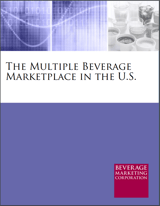 A new report titled The Multiple Beverage Marketplaces in the U.S. by the Beverage Marketing Corporation provides a bird's eye view of the U.S. beverage market, including a detailed cross-category comparison. Learn how key beverage categories have performed recently in the brief excerpt below.
A new report titled The Multiple Beverage Marketplaces in the U.S. by the Beverage Marketing Corporation provides a bird's eye view of the U.S. beverage market, including a detailed cross-category comparison. Learn how key beverage categories have performed recently in the brief excerpt below.
Beverage Category Trends
For the first time in years, the contingent of declining beverage categories did not include what once had been the biggest one by volume but which slipped to second place in 2016. Carbonated soft drinks (CSDs) experienced a long-running losing streak and were surpassed in size by bottled water. After an unusually large decline in the first year of the pandemic, CSDs rebounded in 2021. After declining for three years in a row, beer volume was essentially unchanged in 2020 but decreased slightly in 2021. Milk and fruit beverages both continued to decline in 2021. Coffee and tea also contracted during the year.
- After many years of declining volume, CSDs increased at a faster rate than the overall beverage market in 2021. CSD wholesale dollars decreased at a much higher rate than the U.S. beverage market overall in 2020 but outperformed the market in 2021. The category’s retail sales also declined in 2020, but did so more slowly than the overall pandemic-plagued market, and resumed growth in 2021.
- Beer volume dipped in 2021 but saw growth in wholesale dollars. Flavored malt beverages (FMBs) – especially hard seltzers – added some action to the beer market (which would have seen volume decline without them). Due in part to the loss of sales in bars, restaurants, arenas and other on-premise venues for part of the year, retail sales dropped in 2020. Sales grew rapidly in 2021.
- Fruit beverages declined for a dozen consecutive years before increasing in 2016, when Coca-Cola, PepsiCo and Florida’s Natural all reported growth for their brands. Significant losses resumed in 2017 and continued in 2018, 2019 and 2020. A comparatively small decrease occurred in 2021.
- Milk, also no stranger to volume loss, extended its losing streak for another year in 2021, when a sizeable decline occurred.
- Tea, buoyed by the RTD segment, enjoyed several years of growth, but saw declines from 2017 to 2021. Coffee also declined in 2021.
U.S. Beverage Market Growth
Some other large segments showed strength – especially bottled water and the separate but related value-added water category. Sports drinks also surged.
- Bottled water enlarged its lead over CSDs.
- Value-added water – water with a hint of flavor or some other sort of enhancement – grew even more vigorously, though its volume remained considerably smaller than conventional bottled water’s volume.
- Though overall coffee declined slightly, the small but vibrant RTD sub-segment remained strong.
- Sports beverages declined in 2017 but rebounded in 2018 and continued growing in 2019. Growth accelerated in 2020 and remained strong in 2021.
- Energy drinks advanced forcefully in 2021.
Access the Full Beverage Market Report
 If you need the big picture, the 2022 Multiple Beverage Marketplace in the U.S. by the Beverage Marketing Corporation is for you. This comprehensive data-driven market research report covers the entire U.S. commercial beverage industry and includes statistics on retail and wholesale sales as well as volume, growth, per capita consumption and share of stomach across eleven U.S. alcohol and non-alcohol beverage types. The 2022 edition also features an executive summary highlighting developments and trends, including discussion of the impact of the covid-19 pandemic.
If you need the big picture, the 2022 Multiple Beverage Marketplace in the U.S. by the Beverage Marketing Corporation is for you. This comprehensive data-driven market research report covers the entire U.S. commercial beverage industry and includes statistics on retail and wholesale sales as well as volume, growth, per capita consumption and share of stomach across eleven U.S. alcohol and non-alcohol beverage types. The 2022 edition also features an executive summary highlighting developments and trends, including discussion of the impact of the covid-19 pandemic.
About Beverage Marketing Corporation
Founded in 1972, Beverage Marketing Corporation (BMC) is a leading supplier of information, consulting and financial services specializing in meeting the needs of the global beverage industry. Visit MarketResearch.com to access 50 reports by this publisher. Recent titles include:

